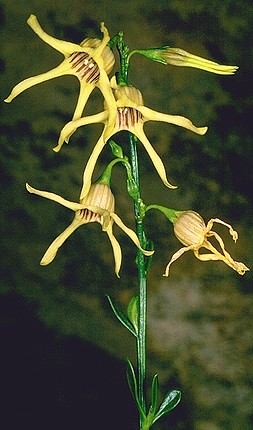
Synonymy
Anthocercis ilicifolia Hook., Bot. Mag. 57: sub t. 2961 (1830) subsp. ilicifolia
T: Swan River, W.A., Fraser s.n.; holo: K; iso: BM, K.
Description
Erect shrub to 2.7 m with 1 or 2 stems, branches often tinged with purple, branches and leaves glabrous, rarely with scattered glandular hairs; seedlings with prickles on stems.
Leaves obovate to narrowly obovate-elliptic, occasionally spathulate or elliptic, sessile or almost so, 15–80 mm long, 7–35 mm wide, thick and fleshy, entire, or the juvenile leaves dentate.
Inflorescence panicle-like, leafless except at base; pedicels 3–8 mm long. Calyx 4–8 mm long; tube funnel-shaped, widest immediately below lobes, maximum diam. 2.5–3.5 mm, thin-textured. Corolla 12–27 mm long, bright yellow, the striations purple to maroon; tube often tinged with purple outside; lobes linear, 6–18 mm long, 3–6 mm wide. Stamens 4–10 mm long; upper stamens 6–7.5 mm long.
Capsule narrowly ovoid-ellipsoid, acute to apiculate, 11–21 mm long. Seeds 1.4–1.9 mm long.
Distribution and ecology
Endemic to the south-western coast of W.A. from south of Kalbarri to Perth.
Grows in calcareous sand; a colonising species common after fire or disturbance.
Notes
Distinct from subsp. caldariola by the funnel-shaped and thin-textured calyx tube and by the wider distribution which does not include the Kalbarri region.
Easily confused with A. littorea Labill., with which it is sympatric; distinguished by the large, pyramidal, leafless inflorescence, brighter yellow flowers, larger corolla tube and broader corolla lobes.
Fruit often malformed due to galling.
Phylogenetic studies by Garcia & Olmstead (2003) on the Tribe Anthocercideae using two chloroplast DNA regions included this species. The studies indicated that Anthocercis is monophyletic.
Reference: V.F.Garcia & R.G.Olmstead (2003). Phylogenetics of Tribe Anthocercideaea (Solanaceae) based on ndhF and trnL/F sequence data. Systematic Botany 28: 609-615.
Selected specimens
W.A.: c. 10 km NE of Jurien Bay, L. Haegi 1906 (AD, CANB, NSW, PERTH); Perth, F.C.Vasek 681005–6 (PERTH).
Derivation of epithet
From Ilex, the holly and folius, Latin for leaf, a reference to resemblance of the leaves of this plant to a holly plant.
Images and information on web
Images of A. ilicifolia ssp. ilicifolia can be seen on the Western Australia Herbarium Florabase website at http://florabase.calm.wa.gov.au/browse/photo?f=315&level=s&id=11725 and on the Canberra Botanic Gardens site at http://www.anbg.gov.au/images/photo_cd/S1103C6085581/004.html
Pharmacology: A discussion of the tropane alkaloids which occur in Anthocercis and other Anthocercideae can be found in Griffith & Lin (2000).
Ref: W.J. Griffin & G.D. Lin (2000). Chemotaxonomy and geographical distribution of tropane alkaloids. Phytochemistry 53: 627–628.
References to the possible toxic properties of Anthocercis species can be found with a search in the
FDA Poisonous Plant Database

